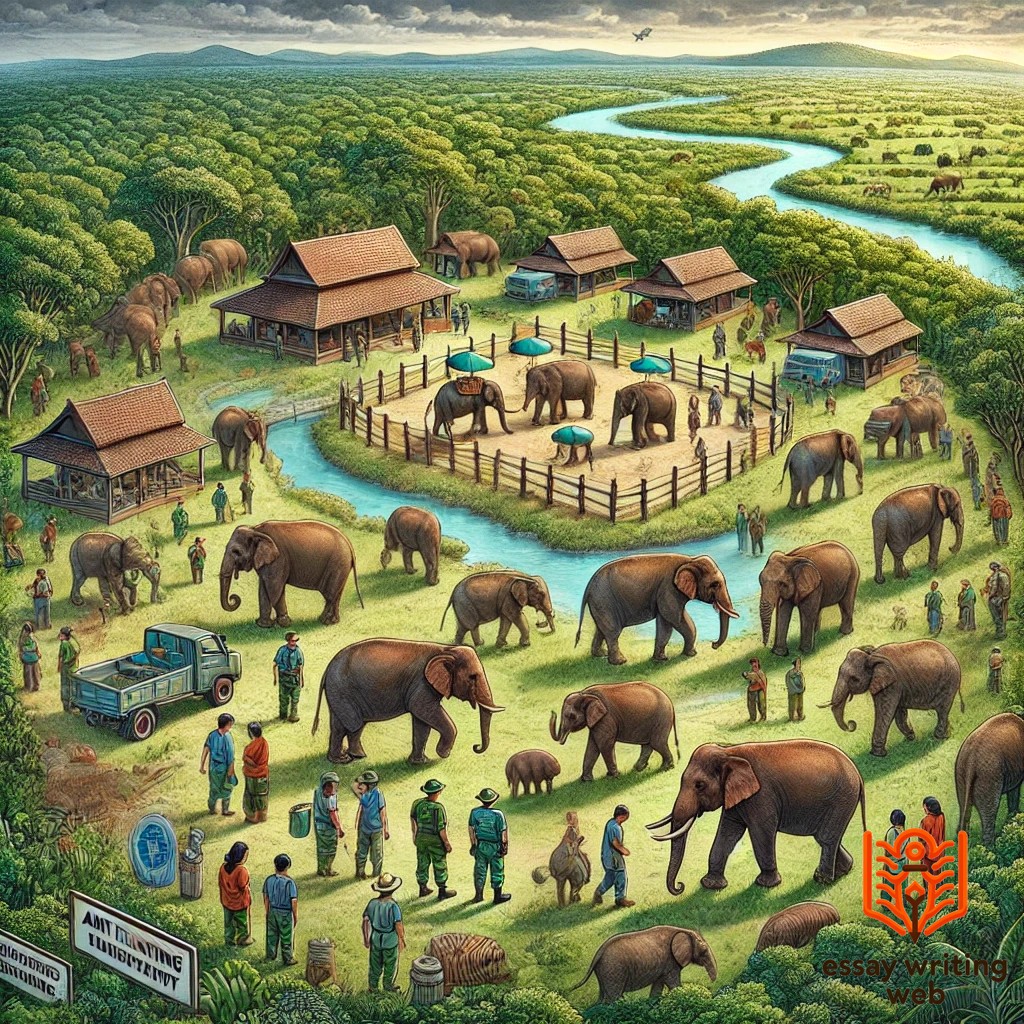 Essay Writing Web
Essay Writing Web
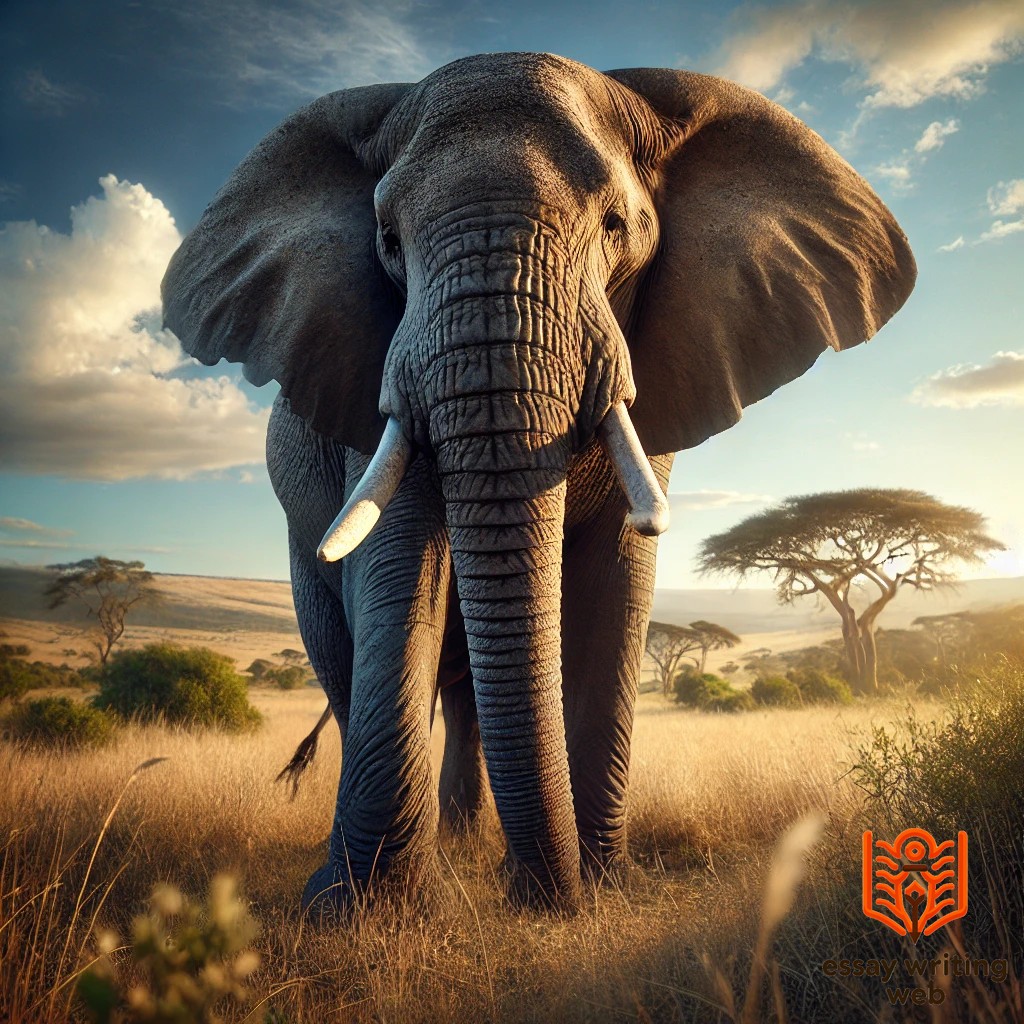
 16-09-2024
16-09-2024
 www.essaywritingweb.com
www.essaywritingweb.com
The elephant, one of the largest land mammals, is a symbol of strength, intelligence, and cultural significance across many parts of the world. Known for their massive size, gentle nature, and striking appearance, elephants are often revered in various traditions, myths, and religious practices, especially in Asia and Africa. Their physical features, such as long tusks, large ears, and a powerful trunk, make them easily recognizable and a favorite subject of fascination for humans throughout history.
Elephants belong to two primary species: the African elephant and the Asian elephant. Both species share similarities but differ in size, ear shape, and habitat preferences. African elephants are generally larger with bigger ears, while their Asian counterparts are slightly smaller and have more rounded ears. Despite their differences, both species play an essential role in maintaining the balance of ecosystems in the regions they inhabit.
Beyond their ecological importance, elephants are known for their intelligence and emotional complexity. They exhibit behaviors such as mourning their dead, using tools, and forming strong familial bonds, which reflect their advanced cognitive abilities. Elephants live in matriarchal herds, led by the oldest female, who guides the group with her knowledge and experience. This social structure highlights the species' deep sense of community and cooperation.
Sadly, elephants face significant threats due to poaching for their ivory and habitat destruction caused by human expansion. Conservation efforts are underway globally to protect these majestic creatures, yet challenges remain. The importance of elephants to biodiversity and the natural world cannot be overstated, making it crucial to raise awareness and implement measures to ensure their survival for future generations.
Thus, the elephant stands as a magnificent creature, embodying both nature's beauty and resilience, deserving respect and protection across the globe.
Elephants are known for their distinctive and imposing physical characteristics, which set them apart as the largest land mammals. The average adult elephant can weigh between 2,000 to 6,000 kilograms, with some reaching heights of up to 4 meters. Their massive size is supported by thick, sturdy legs that help them carry their enormous body weight.
One of the most notable features of an elephant is its trunk, which is a highly versatile and powerful organ. The trunk, an elongated fusion of the nose and upper lip, contains over 40,000 muscles, giving elephants the ability to grasp objects, lift heavy weights, and even perform delicate tasks like picking up small items or drinking water. Elephants use their trunks for communication, feeding, and as a tool in various situations.
Elephants are also characterized by their large ears, which serve a vital purpose beyond their unique appearance. In African elephants, the ears are much larger than in their Asian counterparts and help regulate body temperature by dispersing heat. The blood vessels within the ears act as a cooling mechanism, especially in the hot climates where elephants are commonly found.
Additionally, elephants possess long, curved tusks made of ivory. These tusks are elongated incisor teeth and are used for digging, stripping bark from trees, and defense. Unfortunately, these tusks have made elephants a target for poachers, endangering their survival.
Overall, the physical characteristics of elephants not only contribute to their majestic appearance but also serve practical purposes that enable them to thrive in their natural habitats.
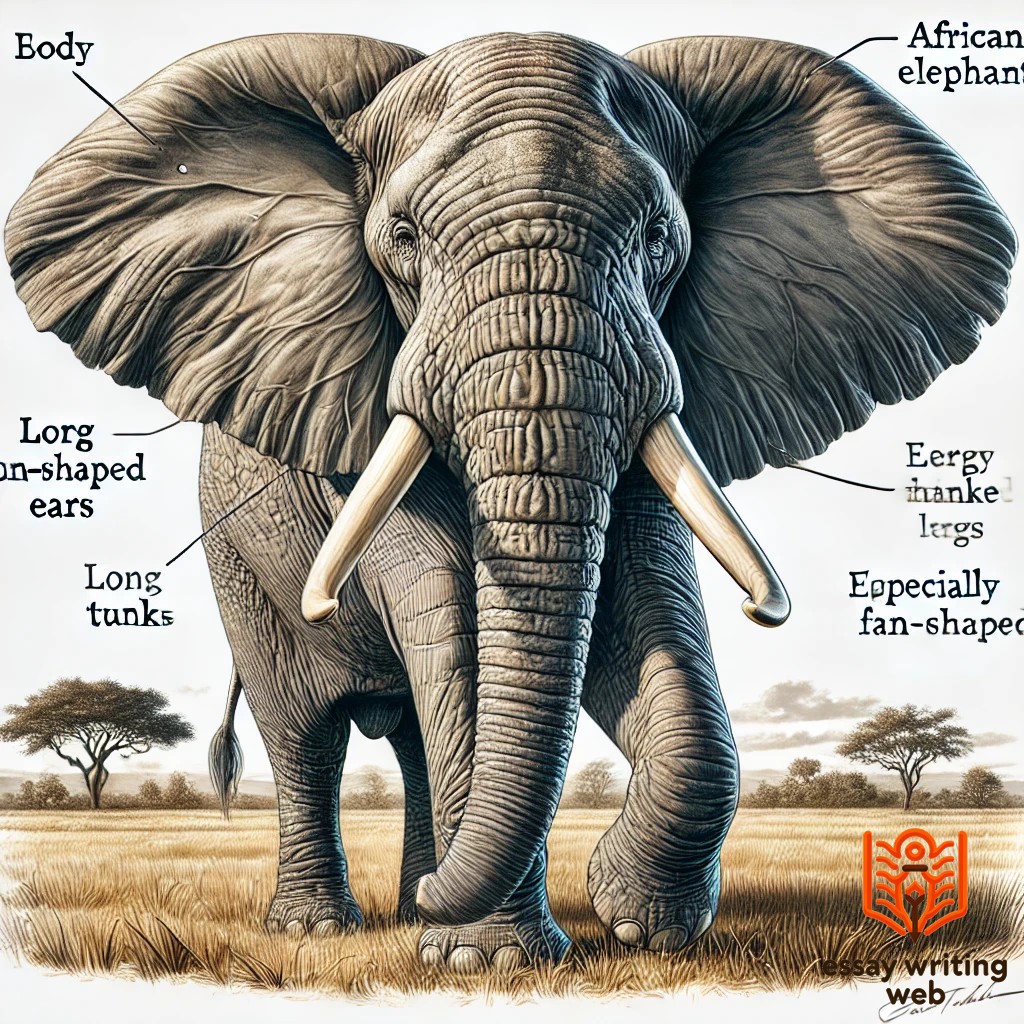
Elephants are classified into two main species: the African elephant and the Asian elephant. Each species has unique characteristics that differentiate them, though they share many common traits as well, such as their large size, intelligence, and strong social structures. Understanding these types provides insight into their distinct habitats, behaviors, and challenges they face in the wild.
The African elephant is the largest of the two species and is further divided into two subspecies: the African savanna (or bush) elephant and the African forest elephant. The savanna elephant is the largest, characterized by its enormous size and large, fan-like ears that resemble the shape of the African continent. These elephants are typically found roaming the vast plains of sub-Saharan Africa. On the other hand, the African forest elephant is smaller, with more rounded ears and straighter tusks, inhabiting the dense rainforests of Central and West Africa. Both subspecies play crucial roles in their respective ecosystems, aiding in seed dispersal and maintaining forest health.

The Asian elephant is slightly smaller than its African counterpart and is native to various countries across South and Southeast Asia. It is identifiable by its smaller, rounded ears and smoother skin. Asian elephants also have a higher-domed forehead and generally lack the large tusks seen in African elephants. In fact, only some male Asian elephants grow tusks, while females rarely do. They are commonly found in countries such as India, Sri Lanka, Thailand, and Myanmar, where they play a significant role in local cultures and traditions.

Both African and Asian elephants face threats from habitat loss and poaching, making conservation efforts vital for their survival. These magnificent creatures, despite their differences, are integral to the biodiversity of the regions they inhabit.
Elephants are herbivorous animals, relying on a plant-based diet that varies depending on their habitat. Their immense size and energy requirements mean that they need to consume vast amounts of food daily, typically between 150 to 300 kilograms of vegetation. Their feeding habits are crucial not only for their survival but also for maintaining the balance of ecosystems where they reside.
Elephants primarily feed on a variety of plant matter, including grasses, leaves, bark, fruits, and roots. African elephants tend to graze more on grass, especially during the rainy season when it is abundant, while in the dry season, they shift to browsing on trees and shrubs. Asian elephants, on the other hand, rely more on bamboo, tree bark, and other forest vegetation found in their tropical environments.
Their trunks play an essential role in feeding. Elephants use their trunks to grab and pull food, strip bark from trees, and even pluck individual leaves. Additionally, their tusks are employed to dig up roots or break branches to access food. Their molars, large and flat, are designed for grinding down tough plant materials into digestible portions.
Elephants typically spend around 16 to 18 hours a day feeding, as their large bodies require a significant intake of food to sustain their energy levels. Because of this, they are known to travel long distances to find enough food, often shaping the landscape and assisting in seed dispersal, which promotes plant growth and biodiversity in their habitats.

Elephants are known for their complex social structures and sophisticated behavior, making them one of the most intelligent and socially advanced species on Earth. They live in close-knit family groups, called herds, which are typically led by a matriarch—an experienced and older female elephant. The matriarch is responsible for guiding the herd, making decisions about movement, feeding, and protecting the group from threats.
The social bonds among elephants are incredibly strong. Herds usually consist of females and their young calves, with male elephants leaving the herd once they reach adolescence to lead more solitary lives or form loose bachelor groups. Female elephants remain with the herd for life, contributing to the stability and knowledge transfer within the group.
Elephants communicate through a variety of vocalizations, including trumpeting, rumbling, and even infrasound, which can travel long distances. They also use body language, such as ear flapping, trunk movements, and touch, to express emotions and intentions. These behaviors reflect their deep emotional intelligence and ability to form strong relationships with each other.
Elephants are known for their empathy and caring behavior. They mourn the loss of members of their herd, show compassion for injured elephants, and work cooperatively in problem-solving. Their complex social dynamics allow them to thrive in their environments, while also showcasing their emotional depth.
Overall, elephants' social structure and behavior highlight their intelligence, emotional complexity, and strong sense of community, which contribute to their success as a species and the vital roles they play in their ecosystems.

In elephant herds, leadership plays a crucial role in the survival and well-being of the group, with the matriarch, the oldest and often the largest female, serving as the leader. This matriarchal structure is central to the social organization of elephants, especially among African and Asian species. The matriarch’s experience, wisdom, and decision-making abilities guide the herd in navigating their environment, finding food, water, and avoiding danger.
The matriarch is responsible for the welfare of the entire group, which typically consists of her daughters, granddaughters, and their young. Her deep knowledge of the herd’s home range, including the locations of essential resources such as watering holes and feeding areas, is passed down through generations. In times of drought or scarcity, it is often the matriarch who leads the group to hidden or long-forgotten water sources, ensuring the survival of the herd.
Her leadership extends to protecting the herd from predators or potential threats. The matriarch is the first to react in dangerous situations, using her experience to decide whether to flee, stand ground, or confront the danger. The younger elephants rely heavily on her guidance in these critical moments.
The matriarch also plays a vital role in maintaining social harmony within the group. She resolves conflicts and ensures that the younger members of the herd are nurtured and protected. Her strong leadership and emotional intelligence bind the herd together, ensuring its stability and continuity over time.
Thus, the matriarch is not just a leader but the backbone of elephant society.
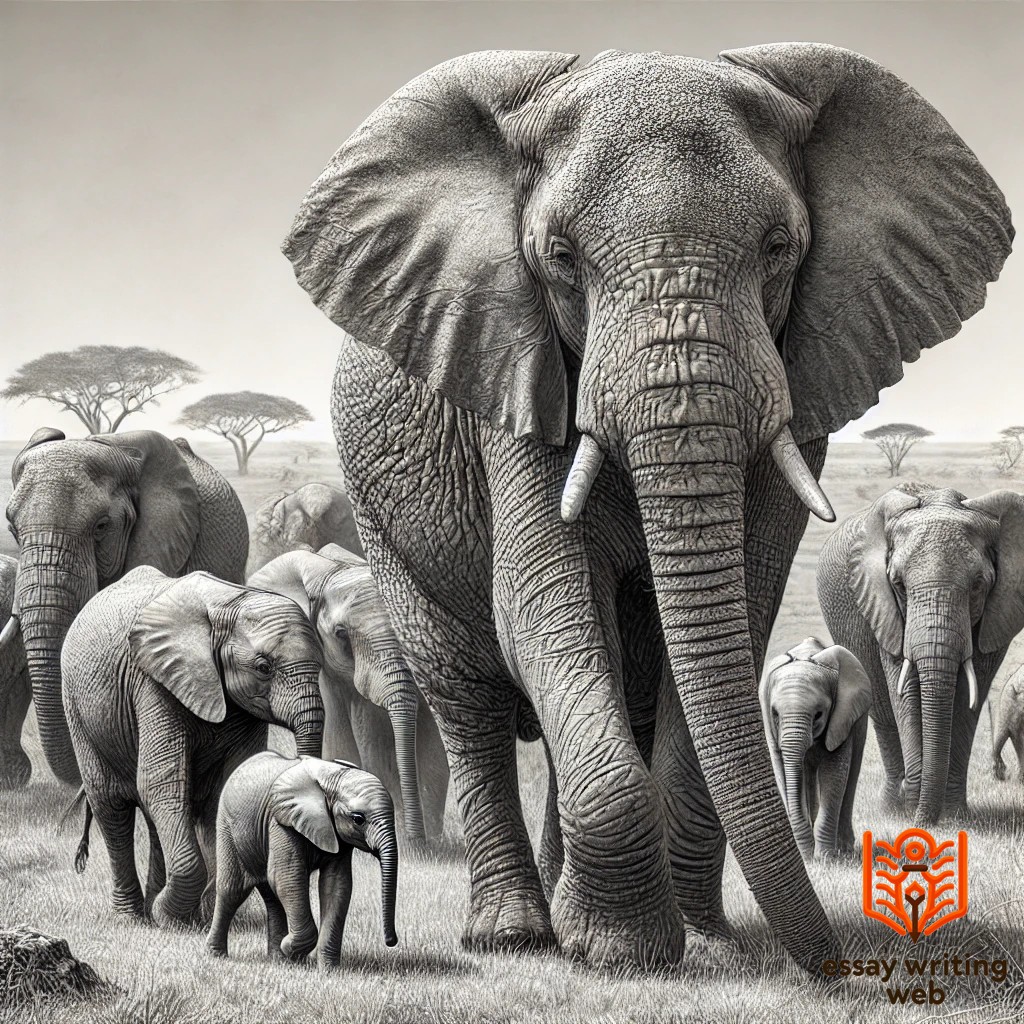
Elephants are highly intelligent and social animals, known for their complex communication methods. They use a combination of vocalizations, body language, and even seismic signals to convey messages to each other across long distances and in close proximity.
Vocalizations play a significant role in elephant communication. Elephants produce a variety of sounds, including trumpeting, rumbling, and roaring. Low-frequency rumbles, known as infrasound, are particularly fascinating because they can travel several kilometers, allowing elephants to communicate over long distances. These vocalizations help them coordinate movements, warn of potential threats, and maintain social bonds.
Body language is equally important in elephant communication. Elephants use their trunks, ears, and posture to express a range of emotions and intentions. For example, an elephant may raise its trunk to signal curiosity or aggression, while flapping ears can indicate excitement or an attempt to cool down. Gentle trunk touches between elephants signify affection, reassurance, or bonding, especially between mothers and calves.
Elephants also use seismic communication, where they detect vibrations through their feet. These vibrations, caused by vocalizations or foot stomps, can alert distant elephants to danger or call the herd together.
Through these sophisticated communication methods, elephants maintain their social structures and respond effectively to their environment.
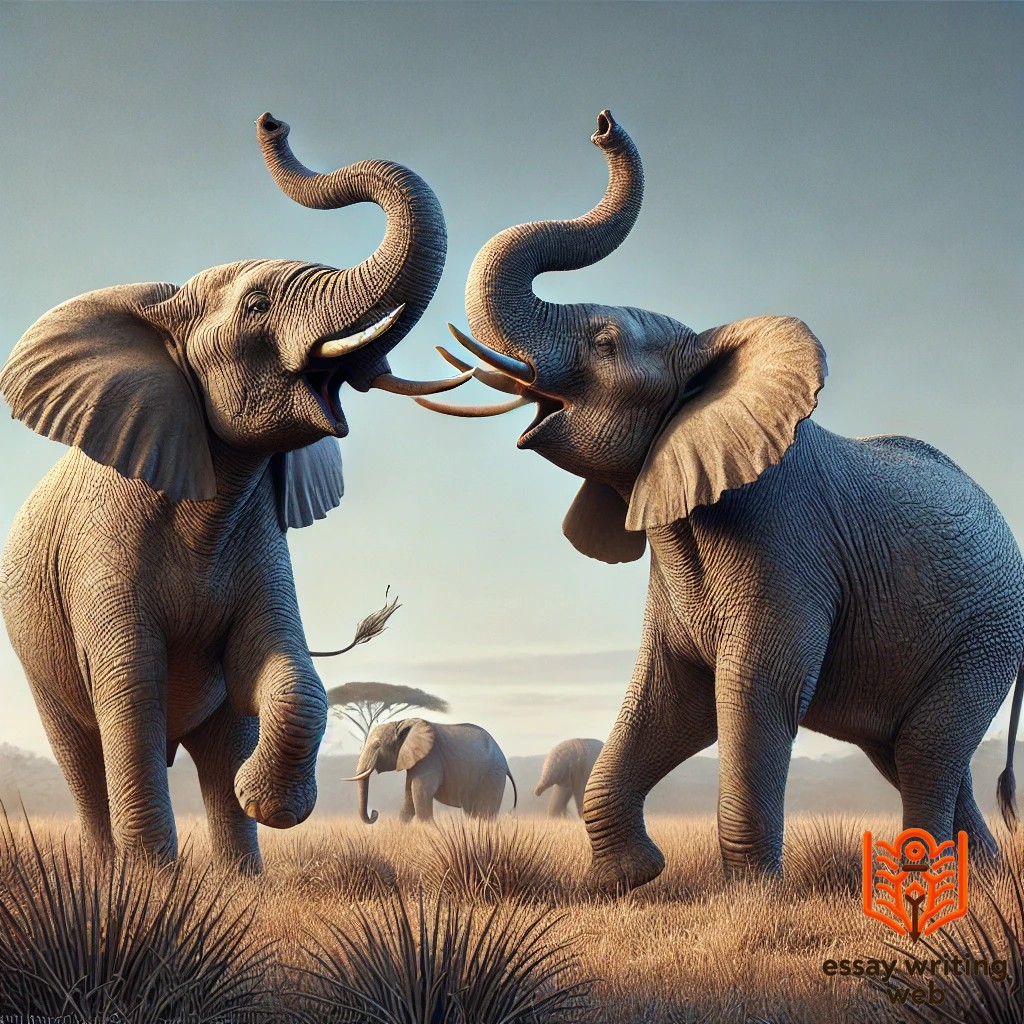
Elephants play a crucial role in maintaining the balance of the ecosystems they inhabit, earning them the title of a "keystone species." Their presence impacts a wide range of flora and fauna, making them essential to the overall health and biodiversity of their environment.
One of the most significant contributions elephants make is through their feeding habits. As they move through forests and savannas, elephants consume large amounts of vegetation, including grasses, leaves, bark, and fruits. In doing so, they help shape the landscape by preventing overgrowth, which maintains open spaces that benefit other species. Additionally, elephants often break branches or knock down trees, creating pathways and clearings that allow sunlight to reach the ground, encouraging the growth of new plants.
Elephants also play a pivotal role in seed dispersal. Many plants rely on elephants to spread their seeds through their dung. As elephants travel long distances, their droppings, rich in seeds, help propagate a variety of plants, promoting the spread of vegetation across vast areas. This, in turn, supports a wider array of species that depend on these plants for food and shelter.
In areas where water is scarce, elephants use their tusks to dig for underground water, creating watering holes that benefit many animals during the dry season.
Through these actions, elephants help maintain the delicate balance of their ecosystems, making them an indispensable part of the natural world. Their loss would have profound and far-reaching impacts on biodiversity and the health of their habitats.
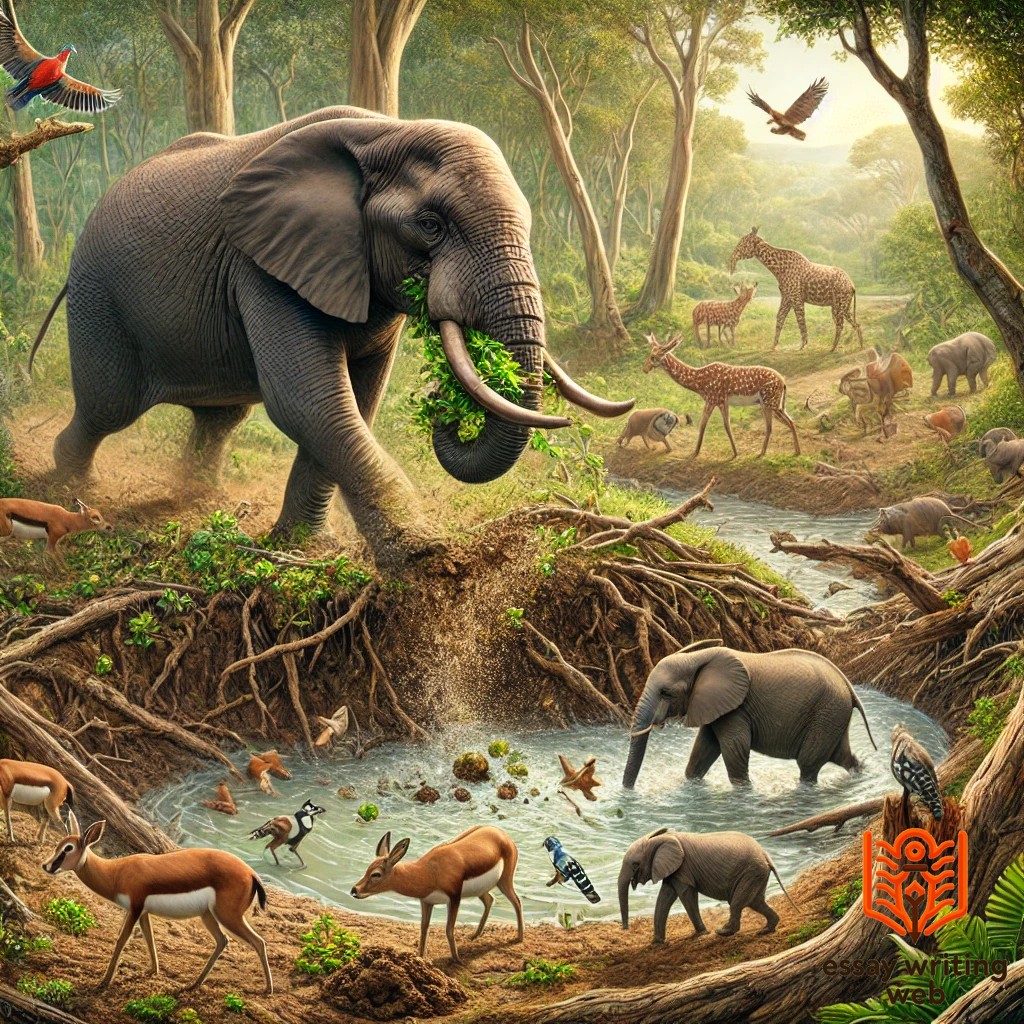
Elephants have long been intertwined with human cultures, playing significant roles in various civilizations throughout history. This relationship, however, is complex, ranging from reverence and domestication to conflict and exploitation. In many cultures, particularly in Asia, elephants are symbols of wisdom, strength, and longevity, appearing in religious rituals, festivals, and art. In countries like India and Thailand, elephants are considered sacred and are often used in ceremonies and processions, symbolizing divinity and power.
Despite the deep cultural connection, elephants are also used in more practical roles, particularly in logging and transportation. Historically, elephants were domesticated and trained to haul heavy loads, particularly in dense forests where machines could not easily operate. Although such practices have reduced in modern times, elephants are still used in some regions for tourism, where they give rides or perform in shows, often under controversial conditions.
Unfortunately, the relationship between humans and elephants is not always harmonious. Habitat destruction due to agricultural expansion, urbanization, and deforestation has led to increasing instances of human-elephant conflict. As elephants’ habitats shrink, they often raid crops, leading to clashes with farmers. Additionally, poaching for ivory has decimated elephant populations, especially in Africa, where the demand for ivory continues to fuel illegal hunting.
Efforts are being made to protect elephants through conservation initiatives, wildlife sanctuaries, and anti-poaching laws. However, balancing human needs with elephant conservation remains a challenge. Understanding and respecting the importance of elephants to both nature and culture is essential for fostering a sustainable relationship.
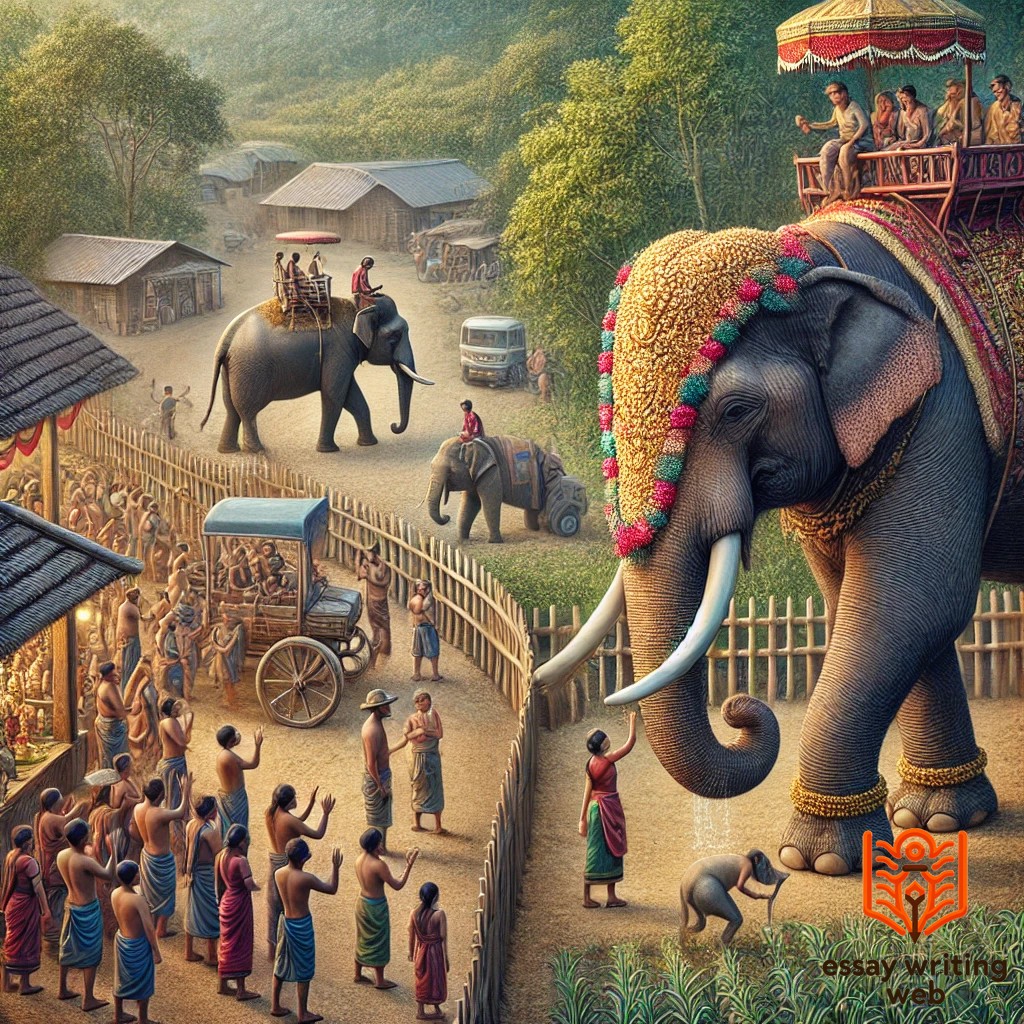
Elephants have historically played a significant role in human activities, particularly in logging, tourism, and religious ceremonies. In the logging industry, elephants have been used for centuries to transport heavy logs in dense forests where machinery cannot easily operate. Known for their strength and intelligence, elephants can skillfully navigate through difficult terrains, moving large loads with precision. While mechanization has reduced their use in modern logging, some regions still rely on elephants for this purpose, especially in parts of Asia.
In the tourism industry, elephants are often used for entertainment, providing rides to visitors or performing tricks in shows. While this generates revenue and raises awareness about these majestic creatures, it has also led to ethical concerns regarding the treatment of elephants in captivity. Many elephants endure harsh training and poor living conditions in the tourism industry, sparking calls for more humane practices and ethical tourism.
Elephants also hold deep cultural and religious significance, particularly in countries like India and Thailand. In religious ceremonies and festivals, elephants are adorned with colorful decorations and celebrated as symbols of divinity, strength, and wisdom. These events, such as the famous Kandy Esala Perahera in Sri Lanka, honor elephants and highlight their sacred status in these cultures.
Despite their utility and reverence, the use of elephants in such industries raises important questions about their welfare and conservation.
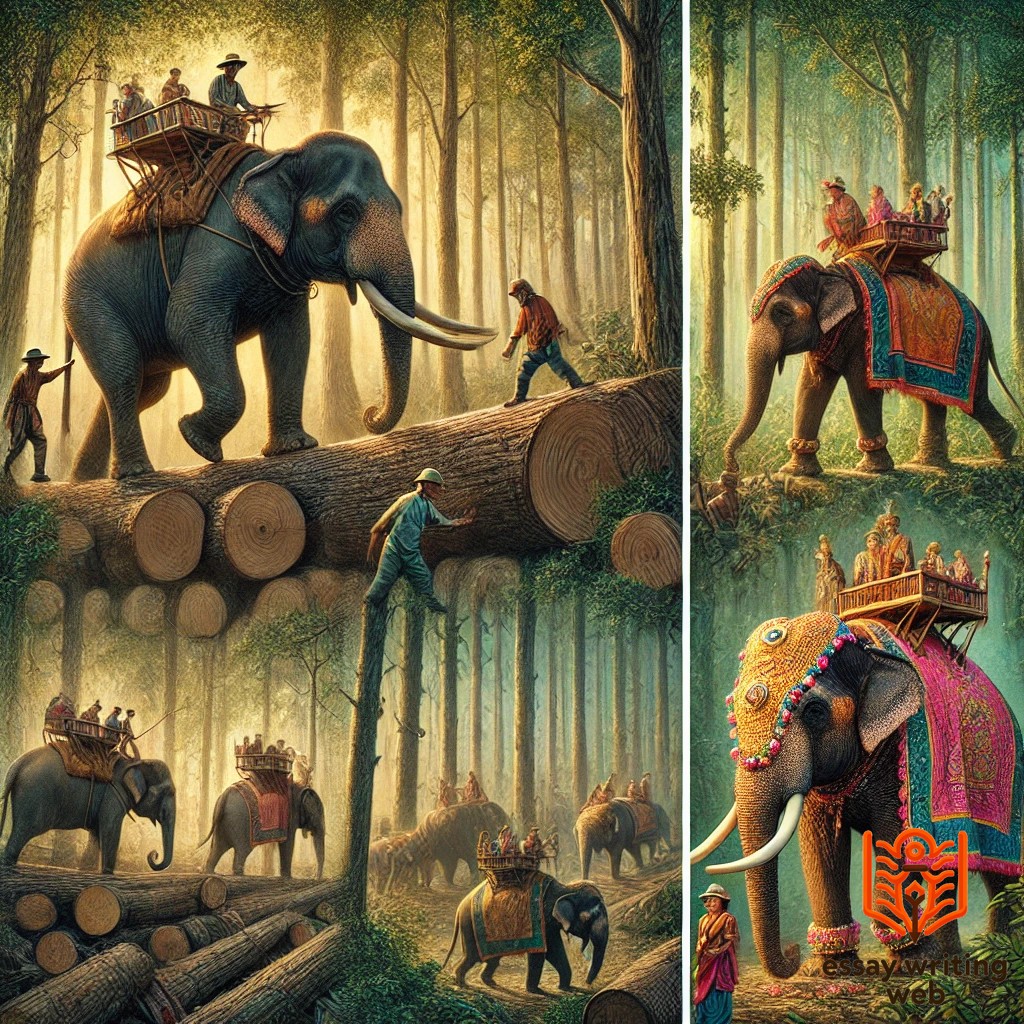
Elephants face significant threats from poaching, habitat destruction, and human-wildlife conflict. To address these challenges, both global and local conservation efforts are critical in ensuring the survival of elephant populations.
On a global scale, organizations like the World Wildlife Fund (WWF) and International Union for Conservation of Nature (IUCN) work to combat poaching by enforcing strict laws against illegal ivory trade. International treaties such as the Convention on International Trade in Endangered Species (CITES) regulate and monitor the ivory trade to curb the demand that fuels poaching.
Local conservation efforts are equally essential, particularly in elephant-range countries. For example, in India, Project Elephant was launched in 1992 to protect elephant populations and their habitats. This program focuses on creating corridors for elephant movement, mitigating human-elephant conflict, and ensuring the protection of key elephant habitats. Similarly, African nations have implemented anti-poaching units and community-based initiatives, like Kenya’s Amboseli Trust for Elephants, which engages local communities in conservation efforts.
In addition, the establishment of wildlife sanctuaries and national parks provides safe havens for elephants. Sanctuaries like Elephant Nature Park in Thailand rescue elephants from exploitation in tourism and logging.
These coordinated efforts, both global and local, are vital to securing a future for elephants in the wild and ensuring that they continue to play their crucial role in ecosystems worldwide.
